Last Updated on December 5, 2019 by asoulwindow
After enjoying the Little Petra and Petra by night, I was curious to see the prehistoric Petra by the day. The rose red city of Petra was listed as the modern 7 wonders of the world in 2007. Petra, declared the UNESCO World Heritage Site in 1985 was long on my radar. It is always more fun to see a destination at different times of the day. The place whispers different things to you. I passed the same rocks and boulders which looked like a monster in the night. First remarkable stop is the Bab el-Siq (Gateway to the Siq) as named by Petra’s Bedouin inhabitants. Siq means a passage. The rocks which I interpreted as monsters in the night are in fact called God Rocks. They stand tall, 6 to 8 metres high as if guarding the scarce water source for Petra’s inhabitants. The river bed that begins at Ain Musa and ends at Petra provided the water to its original inhabitants. The path follows the course of the Wadi Musa. Bedouin folklore has it that the spring gushed when Moses struck a rock in Biblical times.
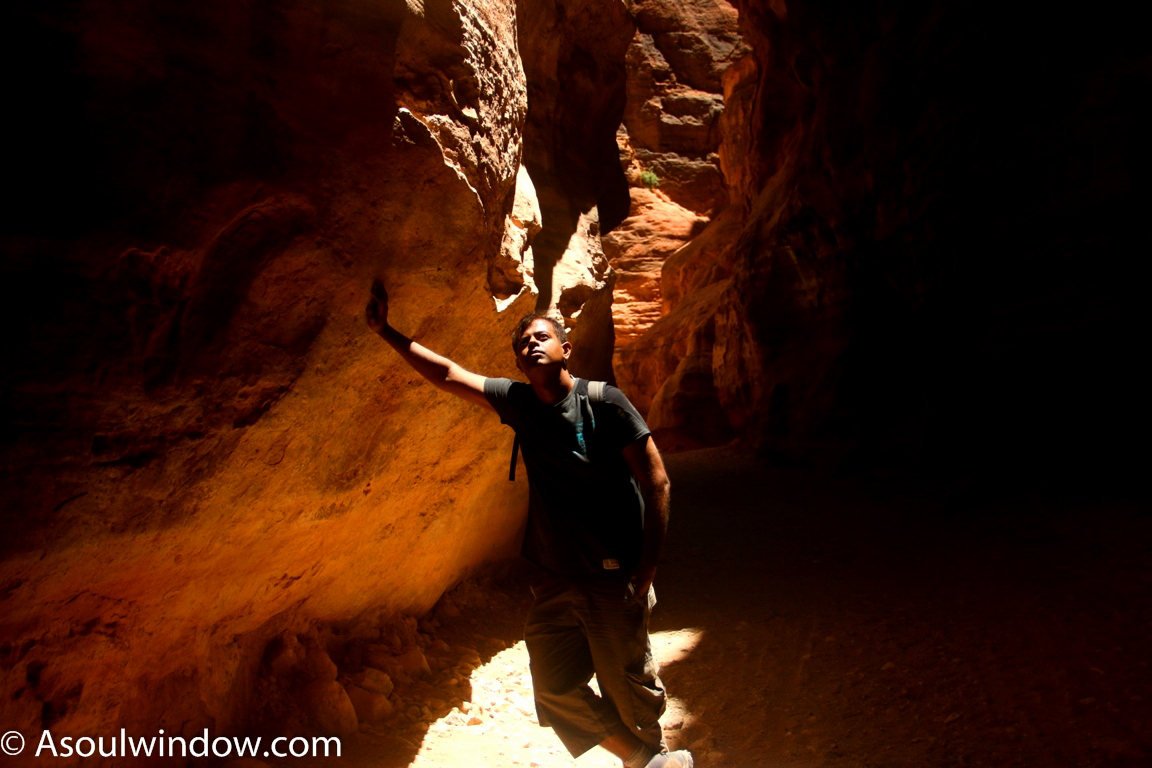
Obelisk Tomb and Bab el-Siq Triclinium (25 to 75 A.D.)
I walked the pathway, neatly divided for the pedestrian and the horse carriages (Only these 2 modes are allowed) to discover more gems. In the opposite direction is Obelisk Tomb and Bab el-Siq Triclinium Two monuments carved into sandstone cliffs sit one upon the other, vying for my attention. The most striking feature of the upper one, Obelisk Tomb, are the 4 pyramid like structures representing Nephesh (A Biblical Hebrew word which refers to the soul of higher animals and human beings). It is a Nabataean sign commemorating the departed souls. Below the tomb is a triclinium (A dining room with a dining table and seats on 3 sides, prevalent in ancient Rome). In the funerary dining hall, wine was served in the banquet held in the honor of God or the ancestor. In the opposite cliff it is mentioned in Nabataean and Greek that the burial monument was built by Admanku. The Greek inscription indicates towards the influence of Hellenic culture in the polyglot Petra.
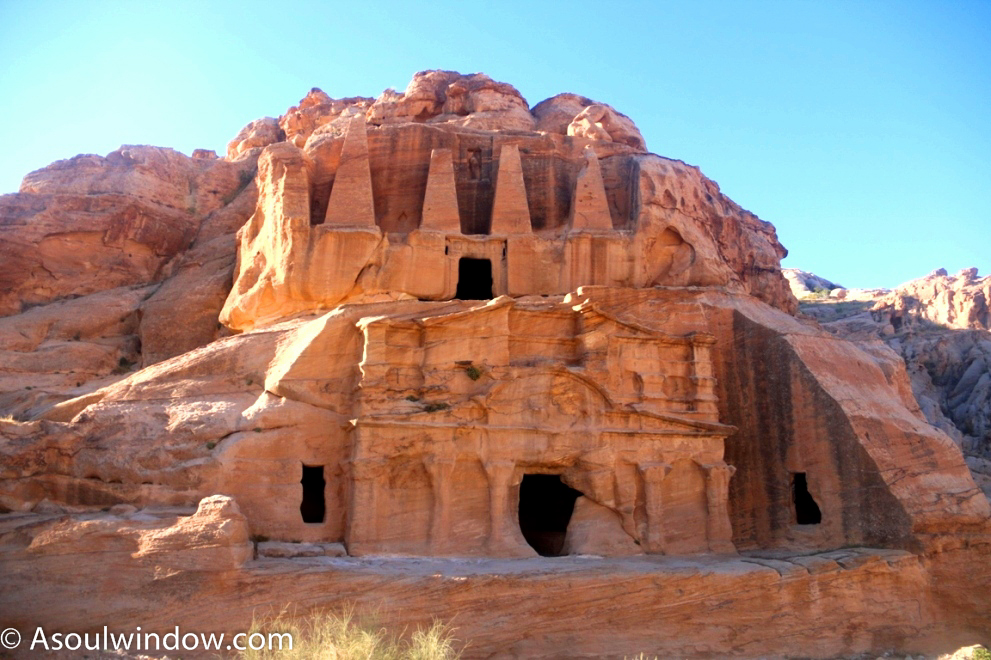
Water Management by Nabataeans
We walked further admiring the awe inspiring valley. The credit for sculpting the dramatic lunar landscape goes to not only the floodwater erosion but also to the Nabataeans who carved water cisterns and water channels which diverted the water into Petra for everyday use. The rugged desert canyon has a mysterious aura to it. A little ahead is Wadi Al Mudhlim, a dry gorge widened by the flow of water. These days, water flows here only during flash floods. In those times, to protect themselves from the flash floods, the Nabataeans built a dam in 1st century B.C. in the area. It also helped them secure water round the year.

An 82 meters long rock cut tunnel redirected water through Wadi Mudhlim to reservoirs, water cisterns and dams. Baetyls (Sacred stones/God blocks) were placed in niches towards the end of the Wadi Mudhlim. Nabataeans valued the water and it was their symbolic way to ensure that the Gods were keeping an eye on the water source. Today a modern dam (1964) stands on the same site, built for the same reason, i.e., to protect Petra’s Siqs from Flash Floods.
Sabinos Alexandros Station (2nd or 3rd Century A.D.)
I observe many of the remnants from the past are still intact such as the paved roads (1st century B.C.), Baetyls and Sabinos Alexandros Station. One of the famous niche in the Siq was carved by Sabinos Alexandros, a religious head from modern day Dara’a (Dusares at Adra’a), Syria. The station is notable for the many baetyls, the domed one depicting the God Dushara (the main Nabataean God) from Adra’a and the one on left is deity Atargatis on 2 lions. (See picture). It was carved by him when he visited Petra along with other masters to honor God Dushara in 2nd or 3rd Century A.D.
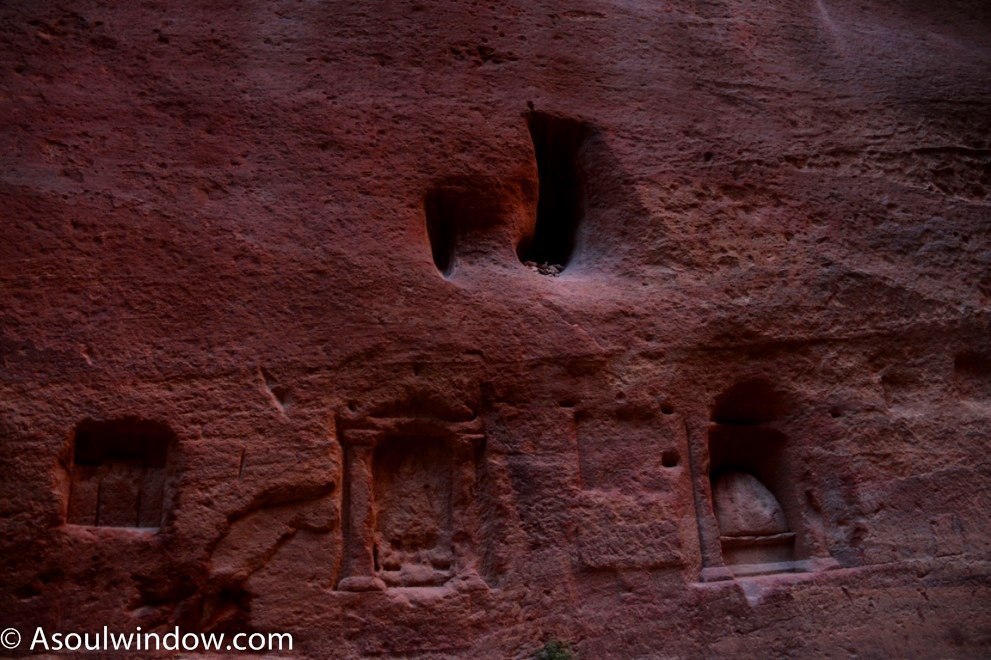
Camel Caravan Reliefs (100-50 B.C.).
A little ahead are Camel Caravan Reliefs. The colossal human forms are at least a third larger than life. It depicts the life in those times, viz, a caravan of camels and men entering Petra. Ten meters above is an eroded carving showing the caravan leaving Petra. The economy of the place which was based on caravan trade saw much traffic in those times. The high hump on one of the camel suggests that the camel is carrying goods. Notice the pleated woolen garment worn by one of the men. In his left arm he is holding a stick.

Treasury aka Al Khazneh (1st century A.D.)
Within minutes, I approach the end of the narrow Siq. It must be the most photographed part of the Siq as it offers a dramatic glimpse of the Treasury aka Al Khazneh. The most recognizable face of Petra, Treasury was built by Nabateans around 1st century A.D. Carved out of a sandstone rock face, it originally served as a mausoleum or crypt (Burial place).
What makes Treasury and other monument of Petra special is the fact that they were not built but carved out of rock with simple chisel. It was sculpted top down. 60,000 cubic feet of rock was chiseled out. Indeed a great feat! 2,000 years later, it is still in great shape today except the erosion of small details and the bullet marks near the urn. It is believed that the local Bedouins shot at the urn in early 20th century, assuming that the bandits have hidden treasure in the urn. It, of course, is just a solid sandstone embellishment.
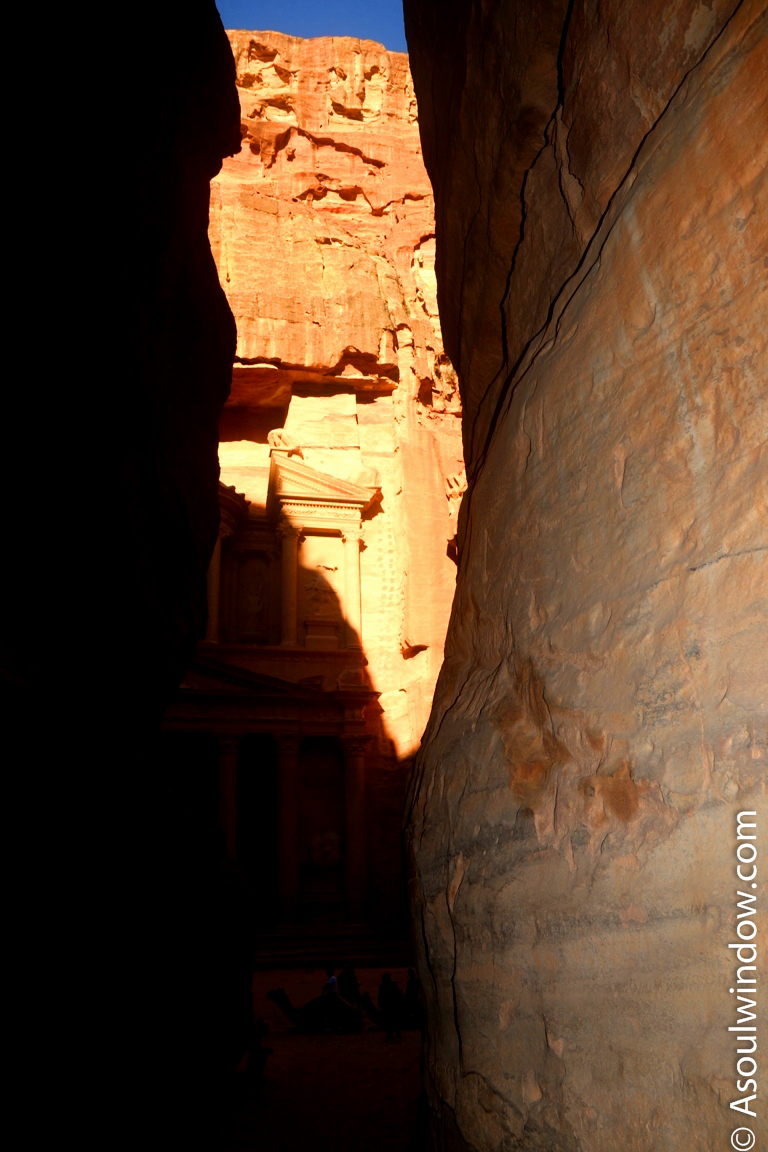
Did You Know About The Mysterious Burial Chamber Under Treasury?
Historians have concluded that the rich carvings on Treasury’s façade depict mythological characters representing afterlife. During the recent excavations, a subterranean burial chamber (accessed by a staircase) was found right under the treasury. The archeologists found the treasure of a different kind. 13 skeletons along with pottery were found in one of the chambers. It is believed that the skeletons belonged to the Royal Nabataean family. The treasury was possibly built to honor the Royal family and was a mausoleum. Visitors are not allowed to enter the underground chamber. In fact mausoleums of many size and shape dominate the landscape of Petra. Their size depended upon the stature of the person in Nabataean society. Ground penetrating radar is used to find many more such gems.

Thanks to the Hellenistic and Roman influence, the architecture of Treasury reflects Greek styles. Corinthian style pillars, eagles and Statues of Castor and Pollux grab the attention. The entire campus of Petra is dominated by tombs and other structures built in Nabataean, Assyrian, Helenistic and Greco-Roman style, indicating the cosmopolitan nature of the ancient city. The overlapping and merging of different styles speaks volumes about those times.
Street of Façades (50 BC- 50 A.D.)
I passed an old man playing Arabic tunes for the amusement of the tourists and reached the Street of Façades. The many rock cut tombs arranged neatly in street like rows grabbed my attention. Built one stop the other, the homogeneous tombs stand out due to their concentration and visually pleasing pattern. The Assyrian architecture style makes the tombs of Petra identical to the stepped design of Mesopotamium architecture (6th and 7th B.C.). Much of the outstanding labyrinth of tombs, burial niches and Tricliniums (funerary dining halls) has been plundered over time. The tomb of Unayshu (1st century A.D.) is remarkable here.

Roman style amphitheater (1st century A.D.)
Opposite the Street of Façades is an impressive Roman style amphitheater. Surrounded by huge mountains on 3 sides, it indicates the Roman influence on the area even before the Romans annexed Petra in A.D. 106. Built in classical Hellenistic style, it seated approximately 8500 people at a time. Carved out of the rock face, the existing tombs were destroyed to create the amphitheater, the evidences of which are still visible at places.

Roman colonnaded street and Nymphaeum (100-200 A.D.)
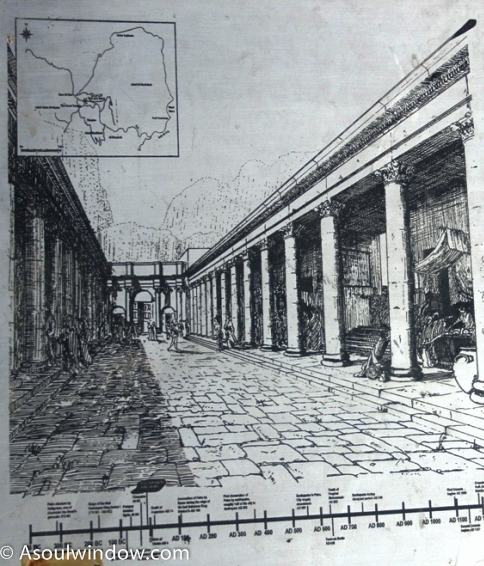
Just as I entered the colonnaded street I came across the remains of a Nymphaeum. A common feature of most Graeco-Roman cities, it was a public drinking fountain named after the nymphs (female nature spirits). Not much of it remains today. However, it once served as a lively place for socializing for the people who frequented Petra. The source of the water was the water tunnels which began at the Siq (See beginning of the story)
The remains of the colonnaded street will transport you to the Roman Era. Built upon an existing dirt and gravel Nabataean street, it ran through the main city center of Petra. The Romans narrowed, paved and straightened the road. It is concluded by the historians that the street may have served as a market place for trading spices, semi precious stones and textiles from India, frankincense from Southern Arabia and East Africa. The colonnades and buildings were destroyed in the severe earthquake of 363 A.D. At present, only 9 columns are standing, thanks to the restoration work. It was a socializing nerve centre of the city, like any other Roman city. There was even a tavern nearby which people frequented for dining and recreation.
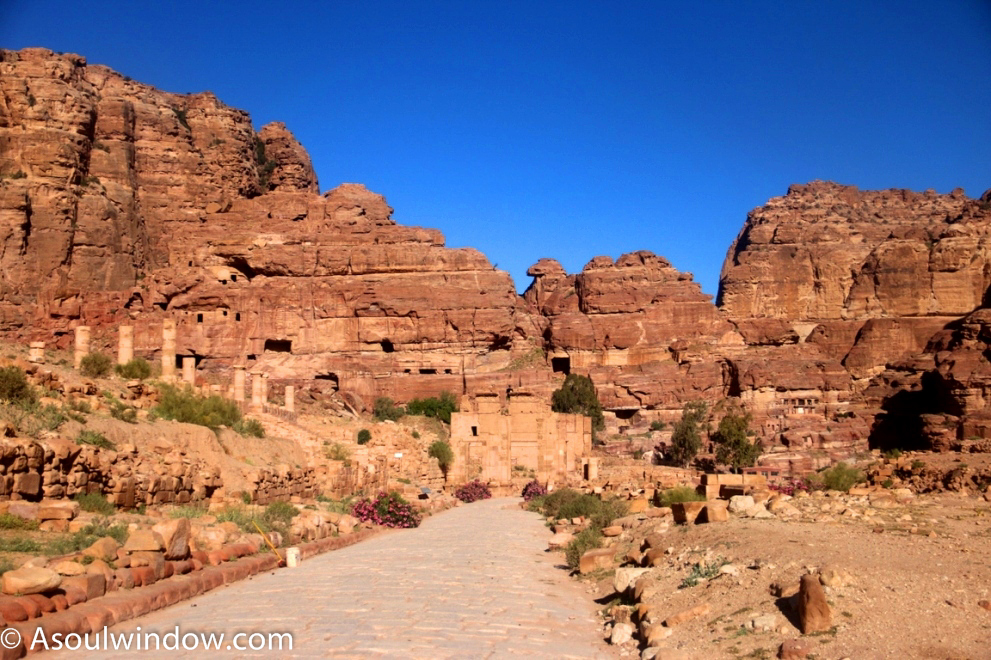
The ‘Great Temple’ Complex (25 B.C.- 100 A.D.)
The largest building in Petra yet uncovered is the ‘Great Temple’ Complex. I climbed a propylaeum (entrance) to arrive at the wide lower precinct of the temple. Everything else except the floor has been destroyed. I imagined a paved courtyard sandwiched by triple colonnades (column/pillar) on either side. 60 columns were lined in each row. Built of carved domes, each column had carved elephant heads, a power of symbol.
The upper precincts, was accessed through a stairway. It had a small open air theater. The semi circular theater was used as a council chamber or judicial assembly hall or perhaps for the entertainment of the elite. A workshop for construction work, subterranean drainage system and bath were some of its other features.

Qasr al- Bint Temple Complex (25 B.C.- 25 A.D.)
The presence of Qasr al- Bint Temple Complex few meters away from the Great temple Complex suggests the secular nature of Petra. It was built around the same time. Possibly a pilgrim destination, it is Petra’s oldest temple complex. There is an interesting story behind Qasr Bint Far’un (Palace of the Pharaoh’s daughter) Legend has it that the Pharaoh promised that any engineer who is successful in building a water channel emptying in the temple will be married to his daughter. During excavations, many water channels were unearthed near the temple complex. Said to be dedicated to God Dushara, it stands out due to its sheer size (23 m tall) and unusual square shape. It is a Hellenistic temple which means that only priests were allowed to go inside while the commoners worshipped from open air termenos. The stairs lead upto the stucco covered Corinthian columns which marked the entrance.
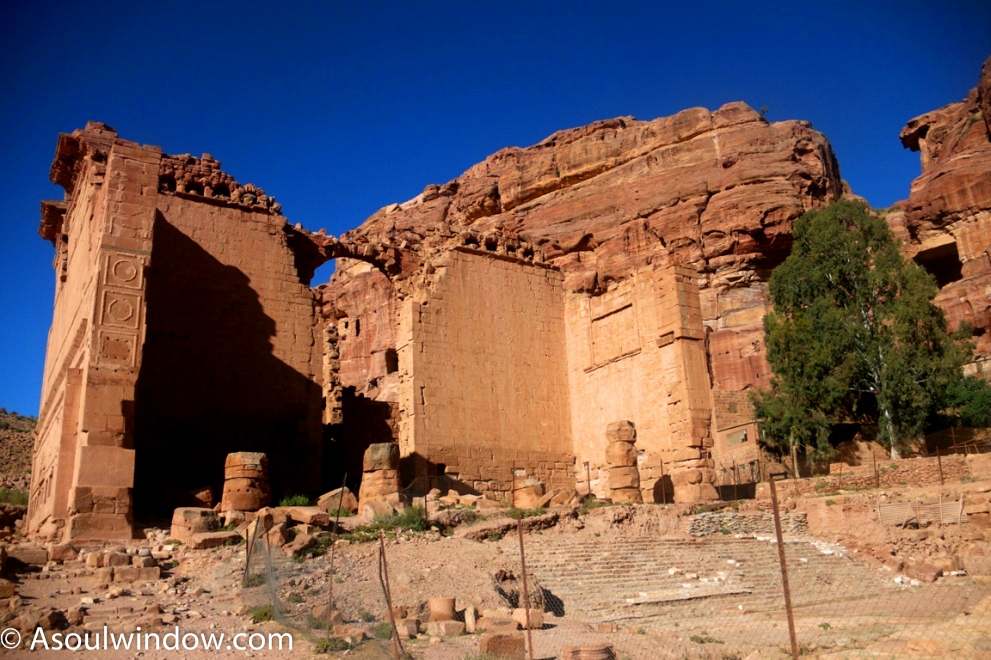
Monastery aka Ad Deir/El Deir (85 B.C. to 110 A.D.)
After exploring the plains at my pace, it was time for me to hike upto the mysterious Monastery aka Ad Deir/El Deir on higher grounds. We passed a board which indicated The Lion Triclinium was nearby. Short on time, we skipped it only to end up indulging in long conversation with a Bedouin woman Firouz Mousa who served us Jordanian Tea as we sat on stairs and talk to her. Small interactions like these are as important as seeing the important edifices. Due to an elevated height and twists and turns, the landscapes were even more dramatic as we kept hiking. Donkeys jostled for space throughout the stairs. One hour later (includes stops), we arrived at the Monastery. Archeologists from western countries were busy in excavating more remains. Much of Petra is still unexcavated. Over the next few decades, I hope to see some exciting new additions in the Petra landscape.
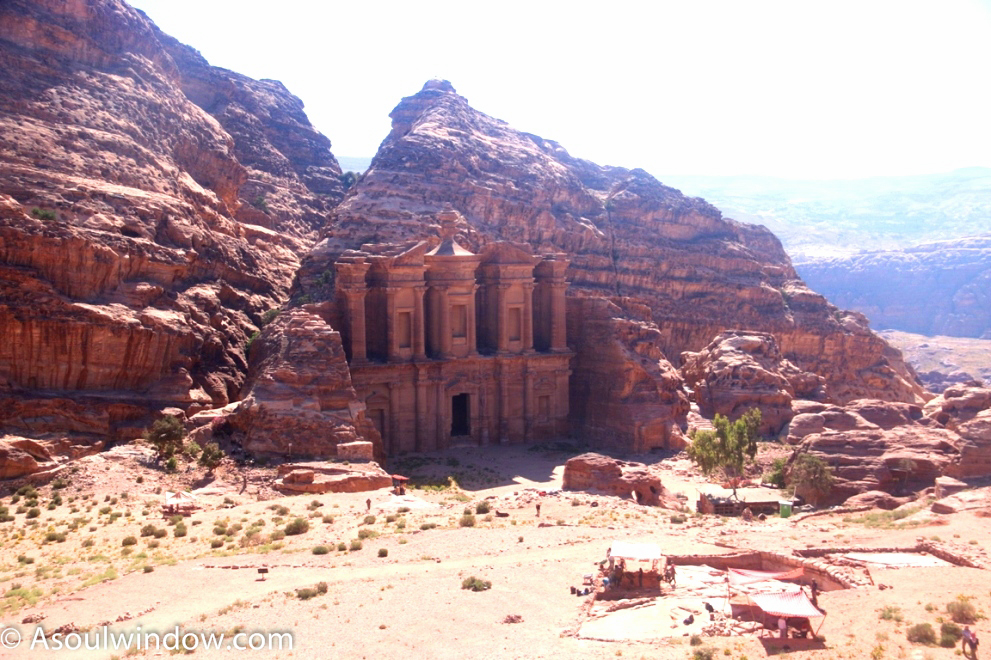
Wadi Araba Viewpoint (As old as time)
We hiked further up to the Wadi Araba Viewpoint. Wadi Araba Crossing is popular with tourists who want to cross the border. (Aqaba in Jordan to Eilat in Israel). As I reached on top of the view point, I was treated with incredible views of Monastery on one side and the mammoth mineral mountains on the other. Miles of colorful (due to minerals) mountains dominated the landscape. Many people return from Monastery. I suggest burn some calories more and see the views from the top. A Jack Sparrow (Pirates Of Caribbean) lookalike sold us tea at the only shop on the top.
We descended to study the Monastery in detail. One of the largest monument in Petra, at first glance it looks identical to the Treasury. However, on close inspection, you realize that instead of the bas reliefs, there are niches to display sculptors. An Alter and the two side benches inside the edifice suggests that it was probably a biclinium and used for holding religious meeting and performing certain rituals. There was a columned portico in front to the façade. It is popularly known as Monastery because it was later used as a Christian Chapel as suggested by the crosses marked in the rear wall.
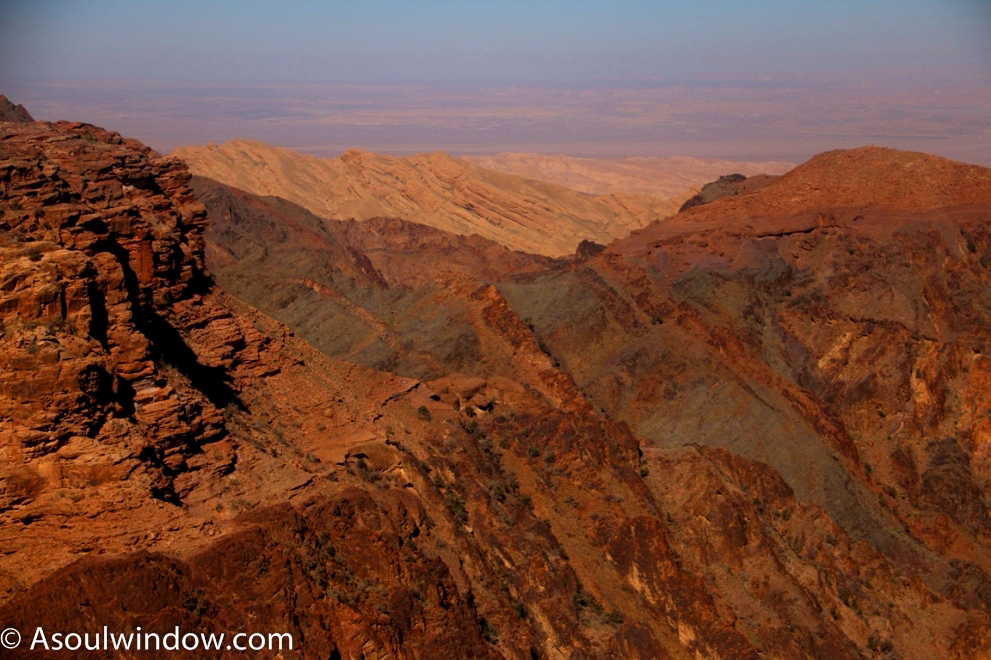
The Decline Of Petra:
What was once a center of power and wealth, started showing signs of decay once the Romans took over. Nabataean paid a heavy price by establishing trade links with Romans. The Romans annexed Petra in 106 A.D. triggering its downfall. The popularity of trade via sea and severe earthquakes thinned Petra’s fortunes further. Eventually the Byzantine empire took over resulting in doom for Petra. There is also a Byzantine Church in the premises. The only documentation from Petra was found in this Church in the form of burnt scrolls written in Greek. It is under analysis right now. It is believed that the Nabataean co existed with Romans and once all was lost they left the place with whatever fortunes they still possessed. The rest was looted. In its heydays, it is believed that upto 30,000 Nabataeans lived in the protected canyon. 5,00,000 foreign travelers lived outside the Petra in tents. That explains the sophisticated cisterns, tunnels and fountains built to meet the demand for water. Once a powerful kingdom, it is an uninhabited land, visited only by tourists and local sellers.

Soul Window Tips:
- Keep at least 2 days to see the monuments. Though one day is also OK, but if you want a deeper experience 2 days are good. That includes time for Little Petra nearby.
- Carry water bottles at all times. The region is dry.
- Hiking upto the monastery is not advised for the elderly or if you have knee or joint issues. Judge for yourself once you are there.
- Beware of the shopkeepers. They will sweet talk you into buying overpriced artefacts.
- Hiking to monastery takes 1 hour with detours and tea stops. Don’t forget water bottles in case you are starting early. Most shops will be shut.
- Clean loos are available throughout.
READ: THINGS TO DO IN RAS AL KHAIMAH
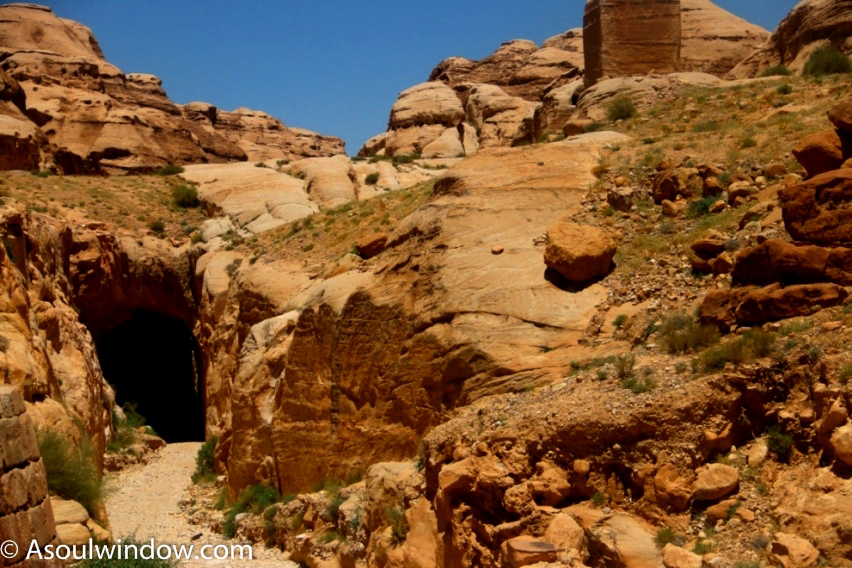
MY MORAL POLICING:
- I personally don’t take animal rides due to ethical reasons. Also Petra is meant to be savoured at slow pace. You will MISS A LOT if you chose to take a horse carriage ride instead of walking.
- If you are fit, please do not hire a donkey to reach the Monastery. The steps are uneven and it will not be a pleasant experience for either you or the poor donkey.
- Please don’t touch the monuments, especially the Treasury and Monastery. Every time you do that you erode the façade.
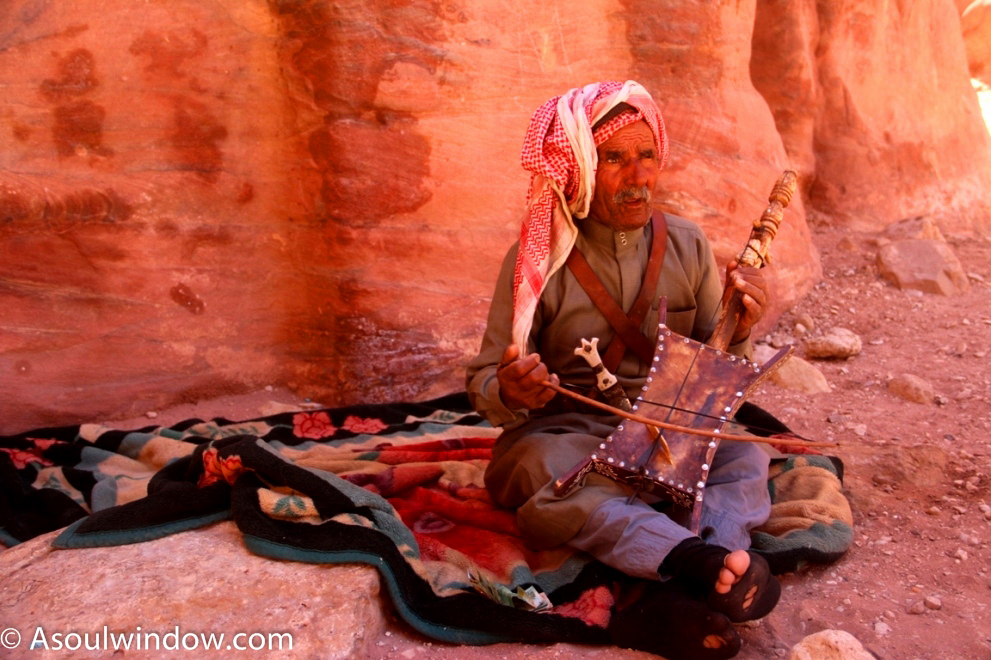
RELATED BLOGS:
PETRA IN NIGHT: IS IT WORTH IT (EXCLUSIVE PICTURES)
AQABA- THE ONLY COASTAL CITY OF JORDAN WHICH BORDERS EGYPT, ISRAEL AND SAUDI ARABIA
AMMAN CITADEL- THE CONTINUALLY HABITATED WALLED CITY
Mövenpick Resort and Residences, Aqaba- The Ultimate Luxury Experience in Aqaba!
AIR ARABIA- HOW TO TRAVEL TO JORDAN ON A BUDGET AND IN STYLE

Spread the love, share this blog
Got any question/comments, ask in the comment section below so that it can benefit other readers.
Email me for collaboration: [email protected]
Be a part of my journey on social media. The travel content I create there is different from this blog.
Pls subscribe/follow/like:

NOTE: I was invited by Jordan Tourism Board to Jordan on a Press Trip
WARNING: COPYRIGHT TO ALL THE IMAGES AND TEXT HERE REMAINS WITH ME. YOU CAN NOT JUST LIFT THE CONTENT AND USE IT WITHOUT MY PERMISSION. STRICT LEGAL ACTION WILL BE TAKEN IF CONTENT IS STOLEN. YES, I AM SERIOUS.
Table of Contents
Related posts:
Top Travel Blogger from India
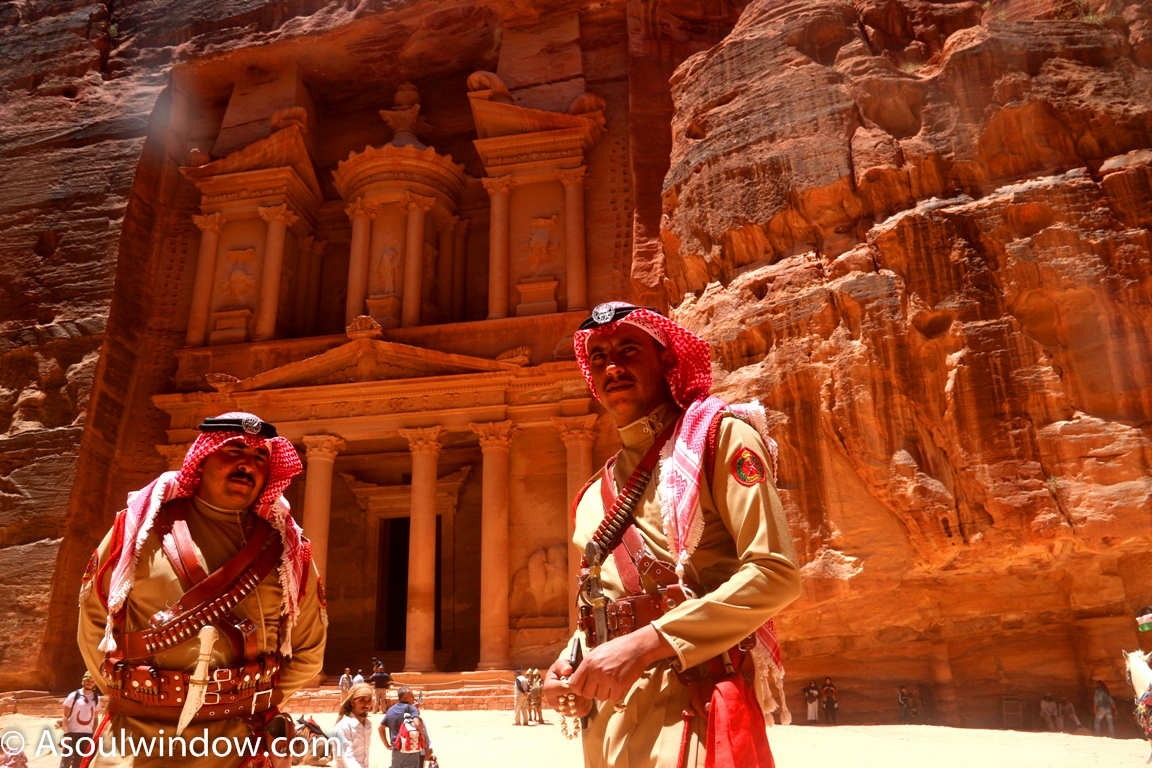
A great article Abhinav… Visiting Petra is already there in my bucket-list and i hope to visit the place soon 🙂
You must. It’s an unforgettable experience. Thank you.
Pingback: ART IN PARADISE 3D MUSEUM IS OFFBEAT AND KID FRIENDLY THING TO DO IN BANGKOK, THAILAND! | A Soul Window - Top Travel Blog from India!
Pingback: OFFBEAT AL NOOR MOSQUE IN SHARJAH IS ALSO CLOSE TO DUBAI- NON MUSLIMS CAN ENJOY FREE DAY TOUR! | A Soul Window - Top Travel Blog from India!
Pingback: WHO WON THE 33RD U.I.M. F1H2O WORLD CHAMPIONSHIP POWERBOAT RACING AT SHARJAH, U.A.E.? | A Soul Window - Top Travel Blog from India!
Pingback: OFFBEAT, ADVENTUROUS & THRILLING SAND DUNE BASHING AT MLEIHA, SHARJAH, U.A.E. PLUS 65000 BILLION YEARS OLD FOSSILS! | A Soul Window - Top Travel Blog from India!
Pingback: FROM BEING FIRED FOR TRAVELING TOO MUCH TO BEING ONE OF THE TOP TRAVEL BLOGGERS OF INDIA- THE JOURNEY OF NOT QUITTING! | A Soul Window - Top Travel Blog from India!
Pingback: 10 REASONS TO BUY FOREX WITH NAFEX! | A Soul Window - Travel Blog from India!
Pingback: Petra, The New Wonder!!! – My wanderlust
Beautiful article on Petra at night & the wadi rum & so much more. Great work done!!
Pingback: AIR ARABIA : CONNECTING PEOPLE, CONNECTING CULTURES AT LOW COST! – Soul Window – Travel stories and pictures from Indian writer
Pingback: VISIT JORDAN: MUST NOT MISS THESE TRAVEL TIPS AND A 7 DAY ITINERARY! – Soul Window – Travel stories and pictures from Indian writer
Petra has been on my mind for long!
You must go soon.
Absolutely magical place 🙂 The landscape looks really stunning. It was a big pleasure to read your story!
Thank you. It sure is a cradle of civilisation
Wow, you’ve delved into so much detail, you could have practicaly published a guidebook on Petra alone!
Thank you. I wish I did that. Would love to go deeper.
The landscape of Petra is totally amazing. Love your tips at the end of the blog for all purposes. Why don’t you include a pin at the end with text written on it.
Thanks. Petra indeed in intriguing and beautiful. Will learn a pin bit. Tech challenged. All I know is writing and clicking. Haha
Pingback: DEAD SEA IN JORDAN – WHY I RAN OUT SCREAMING AS SOON AS I ENTERED IT? – Soul Window – Travel stories and pictures from Indian writer
Pingback: IS PETRA BY NIGHT WORTH IT? ONE OF THE 7 WONDERS OF THE WORLD! – Soul Window – Travel stories and pictures from Indian writer